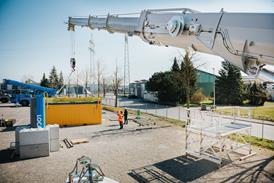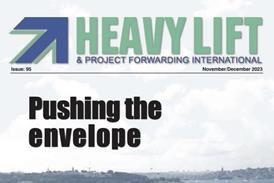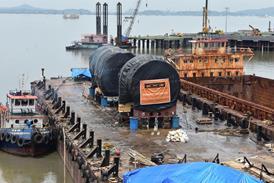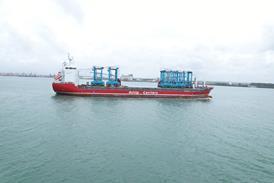January 9 - SAL Heavy Lift has confirmed that its ship, Lone, has completed its upgrade from DP class I to DP Class II.
The heavy lift ship was upgraded during December at the Sietas Group's Norderwerft shipyard in Hamburg.
With her new configuration, Lone is equipped to undertake ambitious projects within the oil and gas industry, as well as offshore wind farms.
SAL , which is now wholly owned by "K" Line, owns both Lone and its twin Svenja, which has a DP class I capability. The company says that the two vessels, each with a combined crane capacity of 2,000 tonnes, have the largest lifting capability for this type of vessel in the world and both feature a high transit speed of up 20 knots.
Dynamic Positioning (DP) is the automatic control of the vessel in its three axes of freedom (surge, sway and yaw). A DP class II certification, which Lone now holds, means that as a result of the equipment specification of the vessel a loss of position will not occur in the event of a failure of any single piece of critical equipment. During offshore installations where workers on platforms and other ships are involved this fact, guaranteed under all but exceptional circumstances, ensures maximum safety for personnel and equipment.
SAL says that Lone is representative of SAL's future strategy: the specialisation in ships with high crane capacity and state-of-the-art technology. Lars Rolner, CEO of SAL states: "The installation of the DP2 system ensures an optimal capability within the highly complex area of oil, gas and wind offshore projects."
According to the shipping line, the operational advantages of a DP class II system is that the vessel is self-propelled - no tugs or static mooring systems required; it is very manouverable and can respond rapidly to weather changes. It can also respond rapidly to changes in project requirements as well as operate in almost any water depth.
With these features in place, SAL says that Lone has all the necessary elements for undertaking complex projects in the area of oil and gas field development as well as offshore wind farm support. Within this scope of service, the vessel can provide wet handshake solutions, FPS0 mooring support as well as transportation and the placement of offshore equipment (such as modules for gas production) on the seabed. In the realm of offshore wind farm support, the vessel can transport and offload foundations such as monopiles and jackets as well as perform the installation of transition pieces.
During the upgrade to DP class II, Lone received one additional 1,200 kW bow thruster, two retractable azimuths each of 1,200 kW and three 1,600 kW auxiliary engines and generators along with a second switchboard and distribution system. To optimise the functionality of the high capacity cranes in offshore operations, the vessel was also equipped with a motion monitoring system.
In mid-December the ship was subjected to a Failure Mode and Effect Analysis (FMEA) trial, as required by class, to test all systems and detect any critical failures that might compromise its capability. The outcome of this trial, which took place in the Baltic Sea over several days, was to the satisfaction of all concerned and confirmed the operational credentials of the vessel. Germanischer Lloyd, the society classing the vessel overall, was thereafter able to issue a DP class II notation.
Apart from its high performance, Lone also possesses an Environmental Passport in line with the highest environmental standards. It is also ISO 140001 and OHSAS 18001 certified. The heavy lift vessel is 160.5 m long, 27.5 m wide and has a loading capacity of 11,000 tonnes or 40,000 cu m cargo volume.
At the end of December, Lone loaded mobile harbour cranes in Rostock before sailing for India and the Far East. In spring of this year the DP 2 system will be utilised during a six months offshore project which will see the vessel load a spooled carousel of 3,500 tonnes and a manifold, both equipment for the oil and gas industry, in the Gulf of Mexico. The cargo will be delivered to the Eastern Mediterranean Sea where the carousel will be unspooled and the manifold will be discharged via a subsea handshake to an installation vessel.















